Abstract
Purpose
To determine the predictive value of certain radiological parameters for an objective asssessment of the presence of ureteral stone impaction.
Materials and Methods
Seventy-nine patients with a single proximal ureteral stones were retrieved from the departmental database. Both clinical and particularly radiological data of all cases were well evaluated on this aspect. In addition to the time period between the first colic attack and definitive management; diameter of proximal ureter and renal pelvis, longitudinal and transverse stone size, Hounsfied unit (HU) of the stone and lastly ureteral wall thickness at the impacted stone site were all carefully evaluated and noted.
Results
Patients had a single proximal ureteral stone. While mean age of the cases was ranged 20 to 78 years; mean stone size was 15.62±4.26 mm. Evaluation of our data demonstrated that although there was a statistically significant correlation between ureteral wall thickness and patients age, transverse diameter of the stone, ureteral diameter just proximal to the stone, renal pelvic diameter and the duration of renal colic attacks; no correlation could be demonstrated between patients sex and the HU of the stone.
Conclusions
Prediction of the presence and degree of proximal ureteral stone impaction is a challenging issue and our data indicated a highly significant correlation between ureteral wall thickness and the some certain radiological as well as clinical parameters evaluated which will give an objective information about the presence of impaction which may in turn be helpful in the follow-up and also management plans of such calculi.
Obstructing ureteral stone(s) have been accepted as “impacted into the ureteric wall” if they remained in the same position for a definite period of time (more than one month). To support this observation and definition stones have also been defined as “impacted” in case of no visualization demonstrated beyond the stone during intravenous urography (IVU) examination [123].
Regarding this issue, “impaction” of a ureteric stone states the process of being buried into the ureteral wall on a time dependant manner. Depending on the degree of ureteric stone induced changes in ureteric wall, this process may closely affect the likelihood of spontaneous passage as well as the final outcome of certain endourological stone removal procedures (shock wave lithotripsy [SWL] and ureteroscopy [URS]) [45].
In an attempt to assess and also quantify the presence and degree of impaction (in other words burying of a stone into the ureteric wall), although as a relatively invasive procedure, IVU has been commonly performed in the past to demonstrate the presence of stone embeddement into the ureteric wall in an objective manner. With this relatively invasive approach, definition of “stone impaction” has been made as “ureteral obstruction with nonvisualization of contrast medium beyond the stone during this radiologic evaluation.” However, as a rarely performed procedure in current practice, this approach has been found to have some certain limitations [67]. Currently noncontrast computed tomography (CT) is the preferred imamging modality with its noninvasive and relaible nature associated with the highest specificity and sensitivity rates [89].
As mentioned above, actually the impaction of a stone means “to be buried” into the ureteral wall. Although this time dependant process is closely affected by stone size to a considerable extent; most importantly the duration of stone presence in the ureter has also paramount importance on this aspect. This condition is particularly important for the stones that are not likely to pass the ureter and stay in the same position for a certain period of time. During this period as a result of the inflammatory changes induced by the interaction between the stone and the surrounding ureteric wall, the formation of edematous changes will cause the calculi to be buriedinto the ureteral wall which in other words is called as the “impaction” of the stone.
Thus, taking the importance of assessment and quantification of the impaction on the clinical course of the stone disease as well as the final outcome of minimal invasive stone removal procedures (SWL-URS) in to account; it will be highly helpful for the radiologists to use some certain radiological parameters to assess the impaction and quantify it in a noninvasive as well as reliable manner [10].
In this present study we aimed to evaluate the reliability of evaluation for some certain radiological and clinical parameters to assess the presence as well as quantification of impaction for stones located in the proximal portion of the ureter.
Between January 2015 and May 2016, of all the cases evaluated and treated for ureteric stones in our department; the database of 79 adult patients (68 male and 11 female patients) with impacted proximal ureteral calculi were retrieved from the patient files, evaluated in a retrospective manner and included into the study program. Study protocol was approved by the Ethics Committee of Dr. Lutfi Kirdar Kartal Training and Research Hospital (approval number: 2016/514/93/1). All steps of the study were planned and applied carefully according to Helsinki Declaration.
CT evaluation was performed by using a 40-MDCT (Siemens Sensation 40, Siemens Healthcare, Erlangen, Germany) in accordance with the protocol of the hospital to detect urinary stones. According to our protocol, patients were scanned from diaphragma to symphisis pubis axially without contrast. Tube voltage 120 kV, pitch: 1, tube current 115 mAs. Sagittal and coronal reformat images were recontructed from raw data to evaluate the longitudinal size of stone. To assess the ureteric wall thickness in an objective way, the distance from the inner to the outer wall of the ureter was measured (a single wall thickness manner) on axial images (Fig. 1). All cases had a single impacted radiopaque stone in the proximal ureter that failed to pass spontaneously causing recurrent renal colic and/or obstruction. Patients undergoing stent placement, open surgery, endoscopic procedures or SWL for a stone in the same ureter or presenting with multiple stones, congenital anomalies or renal insufficiency were excluded from the study program. Proximal portion of the ureter has been defined as the part between the ureteropelvic junction and the lower border of the fourth lumbar vertebra.
In addition to a detailed history and thorough urogenital examination; biochemical evaluation urinalysis and urine culture-sensivity tests have been performed in all cases. As an important parameter all patients were carefully evaluated for the timing of first renal colic attackprior tothe managementwith SWL therapy, in an attempt to have an idea about the duration of the stone presence in the ureter. On the other hand, radiological investigations included mainly plain X-ray of the kidney, ureter and bladder, ultrasound and noncontrast CT in all cases. Depending on the radiologic evaluation findings, the criteria of impaction were further evaluted with IVU occasionally (n=6) along with verification of the presence of the stone (and/or symptoms) in the same position more than one month.
In addition to the assessment of body mass index in all cases; all radiologic parameters which has a potential to give an idea about the degree of stone impaction into the ureteric wall have been derived by making calculations from the CT imagesobtained prior to the SWL procedure in all cases. In this regard, the longitudinal and transverse size as well as the Hounsfied unit (HU) value of the stone have been calculated at first and particularly, the ureteral wall thickness (UWT) at the impacted stone site, the diameter of the ureter proximal to the stone, diameter of renal pelvis were carefully assigned and recorded.
Number Cruncher Statistical System 2007 (Kaysville, Utah, USA) program has been utilized for the evaluation of statistical evaluation of the findings. During the evaluation of study data, in addition to the descriptive statistical methods (mean, standart deviation, median, frequence, rate, minimum, maximum) utilized, Student t-test was used both to evaluate quantitative data as well as to compare normally distributed data between 2 groups. Pearson correlation analysis was used to evaluate the possible relationship between variables. Statistical significance has been evlaueted as “meaningful” at p<0.01 and p<0.05 levels.
Of the 79 patients evaluated (61 men and 18 women; male:female ratio, 3.3); 48 cases had a stone on the right and 31 on the left side. Overall mean patient age was 44.14±13.66 years (range, 20–78 years). While longitudinal stone size ranged from 8–27 mm with a mean value of 15.62±4.26 mm2, mean transverse size of the stone was 7.35±2.55 mm (range, 4–15 mm). Overall mean stone density (standard deviation) was 964.41±320.76 HU (range, 300–1,692 HU) in the whole group. Patient as well as stone related characteristics along with the data for predictive parameters in the whole group are being summarized in Table 1.
Evaluation of the radiological parameters revealed following findings; when we evaluated the UWT values as the most important parameter for stone impaction with the other parameters in a comparative manner; analysis of the possible effect of stone and patient related factors on the presence and degree of impaction into the ureteric wall revealed following findings.
Of the radiological parameters evaluated in this study, stone size particularly thetransverse stone diameterhas been found to be significantly important for the increase in UWT (p=0.001) indicating that if the stone lodges in the ureter in a horizontal manner; embeddment of the calculi into the ureteric wall tended to increase. Related with this subject again regarding the ratio of longitudinal/transverse stone diameter; as this value increased with increasing longitudinal diameter of the stone (longitudinal stone location in the ureter) the value of UWT tended to decrease UWT (p<0.015) indicating the importance ofstone position in the ureter (Table 2, Fig. 2).
On the other hand, the diameter of the ureter proximal to the stone has also been found to be associated with UWT in a positive manner. As the diameter of the ureter at this part increased the value of UWT increased accordingly (p<0.001). This finding indicated that as the embeddement of the stone into the ureteral wall increases it will increase the degree of obstruction resulting in significantly dilated proximal ureteral portion (Table 2, Fig. 3).
The same findings were valid for the assessment of renal pelvic diameter of the affected reno-ureteral unit. As the renal pelvic antero-posterior diameter increased (degree of hydronephrosis) the value of UWT tended to increase significantly (p=0.067) in a parallel manner (Table 2, Fig. 4). This finding again let us to think that as the embedment of the stone into the ureteral wall increases it will increase the degree of obstruction resulting in significantly dilated renal pelvic diameter.
Regarding the patient related clinical parameters, patient's age and the duration of renal colic period prior to stone removal have been found to be associated with changes in UWT in other words stone impaction. Related with this issue our data clearly demonstrated that as the age of the case with ureteral stone increased the thickness of the ureteral wall at the stone site did increase in a significant manner (p=0.006) (Table 3).
The same significant correlation was valid for the total duration of colic attacks and UWT; where this period increased in accordance with the increased UWT values (p=0.005) (Table 2, Fig. 5). Related with the clinical parameter again although the mean UWT values did seem to be higher in male cases when compared with females (5.79±2.98 mm vs. 4.33±2.66 mm, respectively) this difference was not statistically significant (p=0.067) (Table 3).
In addition to the UWT evaluation on CT examination; secondary but valuable findings of ureteral obstruction were also evaluated on CT images and while perirenal fat stranding was present in 5 cases (6%); periureteral fat stranding was present in 64 cases (80%).
Last but not least as an important radiological parameter; evaluation of stone hardness in terms of HU value assessment did not reveal any significant correlation between stone hardness and that of UWT (p>0.05) (Table 2).
Both the definition as well as the management of impacted ureteral calculi constituted a clinical controversy for the practising urologists and the objective assessment of impaction for a well planned treatment of such stones is stil a matter of discussion [21112]. Accumulated literature data have well demonstrated that the as the stone gets buried into the ureteric wall, this condition (often being called as “impaction”) may affect not only the spontaneous passage rates; but also the ultimate success as well as procedure related complications of endourological stone removal methods [11213141516].
Related with this issue, impaction (or in other words “to be buried into the ureteric wall”) of the stones will become evident over time as the stone(s) reside in the same position for a reasonable period of time and although as a relatively invasive procedure IVU has been commonly applied for a reliable assessment in the past; in todays contemporary conditions, objective and reliable assessment of this important phemenon could be made by evaluating the images obtained by abdominal noncontrast spiral CT. As mentioned above, impaction of a stone means “to be buried” into the ureteral wall and this time dependant process seems to be closely related with the size of the stone(s). As the stone stays in the same position, increasing inflammatory changes induced by the stone on the ureteric wall over time, the formation of edematous changes will cause the stone to be further buried into the ureteral wall.
As mentioned above, up to now the definition of “stone impaction” has been mainly made based on the subjective criteria and the objective assessment required either IVU evaluation or observation of the intraoperative findings in the past both of which were reasonably invasive procedures [111213]. This situation led the endourologists/radiologists to look for and use some pratical, noninvasive methods or parameters to define the presence as well as the quantification of impaction. It is clear that the use such practical, noninvasive parameters will let us to predict the likelihood of sponataneous passage and more imprtantly to lower the chance of complications which may be well encountered during the endourological removal procedures.
Regarding this issue, in our recently published study, to predict the success rates as well as the need for auxiliary procedures after SWL in proximal ureteral stones; we were able to show that the UWT at the portion of the ureter where the stone has been found to be buried into the ureteric wall was highly informative to predict the final outcome SWL procedures in terms of the parameters mentioned above. It is well known that depending on the duration of stone presence at the same portion of the ureter, increasing inflammation and the edematous changes will result in an increased thickness of the ureteric wall at this site [10].
Additionaly, in another study evaluating the possible predictive parameters for the success of medical expulsive therapy (MET); again UWT was found to be highly predictive for the success rates of MET. These findings further supported the predictive value of UWT on the success of certain management approaches for such stones by providing objective information about the degree of stone impaction due to the facts mentioned above [17].
These findings demonstrate well that the ureteral stone(s) residing in the same potion of the ureter for a relatively longer period of time will furher bury into the ureteral wall (in other words embedded into the ureteric wall) due to the inflammatory reaction induced tissue changes on the wall of the involved ureter [13]. Depending on the presence and degree of these changes, the thickness of the ureter will increase in a stone size as well as time dependant manner which may clearly and of course objectively reflect the degree of impaction in an objective manner.
Taking the importance of UWT in the objective and practicle radiologic assessment of stone impaction into account; in this present study we aimed to determine the possible association of some certain clinical as well as radiological parameters with the UWT for objective assessment as well as follow-up of ureteral stone impaction. Evaluation of findings have clearly pointed out that in addition to the transverse stone diameter; diameter of proximal ureter and antero-posterior diameter of renal pelvis; of the clinical parameters evaluated, patient's age and the duration of renal colic period prior to stone removal procedure have been found to be associated with changes in UWT in other words stone impaction. In addition to the UWT evaluation on CT examination; secondary but valuable findings of ureteral obstruction were also evaluated on CT images and while perirenal fat stranding was present in 5 cases (6%); periureteral fat stranding was present in 64 cases (80%). Thus, these radiologic parameters seem to be related with the UWT which could be regarded as a highly objective parameter for the presence as well as degree of stone impaction into the ureteric wall.
In the light of our current finding, we may state that the objective assessment and also follow-up of “ureteral stone impaction” will allow us to predict the possible clinical course of the stone disease and also make a appropriate plan for the proper removal of these stones with higher succes and lower complication rates. Our results did clearly demonstrate that as the size as well as the transverse/longitudinal diameter ratio of the stone increases; the stone will further bury into the ureteric wall and obstruct the system which may in turn result in evident dilation of the upper urinary tract. Morover, stones in elderly cases as well as stones being located in the same position for a long period of time will high likely impact into the ureteral wall further when compared with the other cases. In summary, the proper timing as well as plan for a successful stone removal procedure in such cases should be done carefully in an individually based manner.
Our study may have only one limitation where the number of cases included and evaluation in our study may be small but taking the lack of publications regarding this issue and the first introduction of such parameters to assess the impaction status of the stone into account; we believe that our current findings will certainly be contributive enough to the existing literature on this critical subject.
Impaction of ureteral stones is a challenging issue which may closely affect the clinical course of stone passage as well as the final outcome of stone management procedures. Noninvasive radiological assessment and quantification of stone impaction will allow the endourologist to use such practical parameters in all cases in order make a proper management plan for a successful and complication free procedure. However we believe that further studies with larger number of cases are certainly needed for more reliable outcomes.
References
1. Mugiya S, Ito T, Maruyama S, Hadano S, Nagae H. Endoscopic features of impacted ureteral stones. J Urol. 2004; 171:89–91. PMID: 14665851.

2. Deliveliotis C, Chrisofos M, Albanis S, Serafetinides E, Varkarakis J, Protogerou V. Management and follow-up of impacted ureteral stones. Urol Int. 2003; 70:269–272. PMID: 12740489.

3. Morgentaler A, Bridge SS, Dretler SP. Management of the impacted ureteral calculus. J Urol. 1990; 143:263–266. PMID: 1967657.

4. Seitz C, Tanovic E, Kikic Z, Fajkovic H. Impact of stone size, location, composition, impaction, and hydronephrosis on the efficacy of holmium:YAG-laser ureterolithotripsy. Eur Urol. 2007; 52:1751–1757. PMID: 17459573.

5. Wolf JS Jr. Treatment selection and outcomes: ureteral calculi. Urol Clin North Am. 2007; 34:421–430. PMID: 17678991.

6. Takahashi N, Kawashima A, Ernst RD, Boridy IC, Goldman SM, Benson GS, et al. Ureterolithiasis: can clinical outcome be predicted with unenhanced helical CT. Radiology. 1998; 208:97–102. PMID: 9646798.

7. Fielding JR, Silverman SG, Samuel S, Zou KH, Loughlin KR. Unenhanced helical CT of ureteral stones: a replacement for excretory urography in planning treatment. AJR Am J Roentgenol. 1998; 171:1051–1053. PMID: 9762995.

8. Fowler JC, Cutress ML, Abubacker Z, Saleemi MA, Alam A, Shekhdar J, et al. Clinical evaluation of ultra-low dose contrast-enhanced CT in patients presenting with acute ureteric colic. J Clin Urol. 2011; 4:56–63.

9. Varanelli MJ, Coll DM, Levine JA, Rosenfield AT, Smith RC. Relationship between duration of pain and secondary signs of obstruction of the urinary tract on unenhanced helical CT. AJR Am J Roentgenol. 2001; 177:325–330. PMID: 11461855.

10. Sarica K, Kafkasli A, Yazici Ö, Çetinel AC, Demirkol MK, Tuncer M, et al. Ureteral wall thickness at the impacted ureteral stone site: a critical predictor for success rates after SWL. Urolithiasis. 2015; 43:83–88. PMID: 25417717.

11. Morgentaler A, Bridge SS, Dretler SP. Management of the impacted ureteral calculus. J Urol. 1990; 143:263–266. PMID: 1967657.

12. Srivastava A, Ahlawat R, Kumar A, Kapoor R, Bhandari M. Management of impacted upper ureteric calculi: results of lithotripsy and percutaneous litholapaxy. Br J Urol. 1992; 70:252–257. PMID: 1422683.

13. Elganainy E, Hameed DA, Elgammal M, Abd-Elsayed AA, Shalaby M. Experience with impacted upper ureteral stones; should we abandon using semirigid ureteroscopes and pneumatic lithoclast. Int Arch Med. 2009; 2:13. PMID: 19409107.

14. Juan YS, Shen JT, Li CC, Wang CJ, Chuang SM, Huang CH, et al. Comparison of percutaneous nephrolithotomy and ureteroscopic lithotripsy in the management of impacted, large, proximal ureteral stones. Kaohsiung J Med Sci. 2008; 24:204–209. PMID: 18424357.

15. Roberts WW, Cadeddu JA, Micali S, Kavoussi LR, Moore RG. Ureteral stricture formation after removal of impacted calculi. J Urol. 1998; 159:723–726. PMID: 9474134.

16. Leijte JA, Oddens JR, Lock TM. Holmium laser lithotripsy for ureteral calculi: predictive factors for complications and success. J Endourol. 2008; 22:257–260. PMID: 18294030.

17. Sahin C, Eryildirim B, Kafkasli A, Coskun A, Tarhan F, Faydaci G, et al. Predictive parameters for medical expulsive therapy in ureteral stones: a critical evaluation. Urolithiasis. 2015; 43:271–275. PMID: 25820291.

Fig. 2
Evaluation of the relationship between ureteral wall thickness and longitudinal/transverse (L/T) size of the stone ratio.
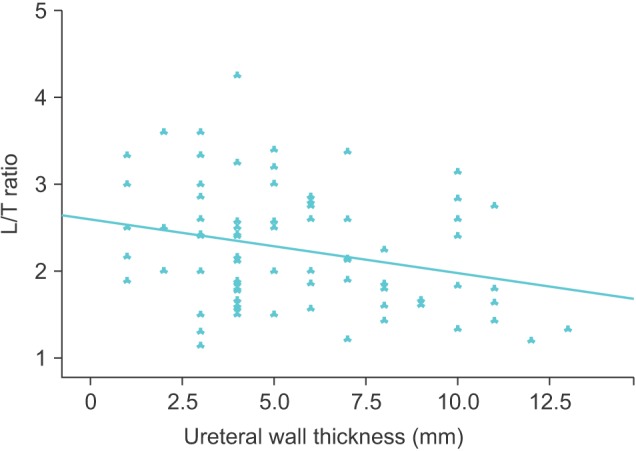
Fig. 3
Evaluation of the relationship between ureteral wall thickness and proximal ureteral diameter.
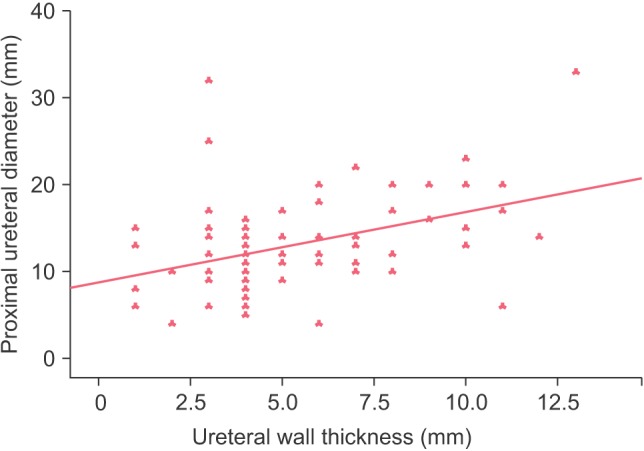
Fig. 5
Evaluation of the relationship between ureteral wall thickness and the pain period before treatment.
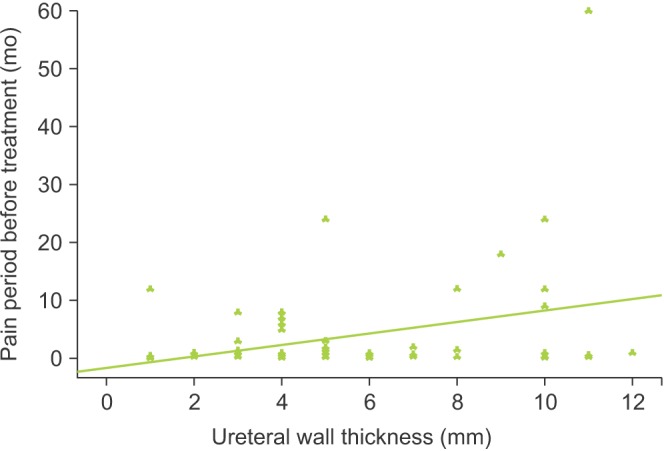
Table 1
Evaluation of the patient as well as stone related radiological parameters
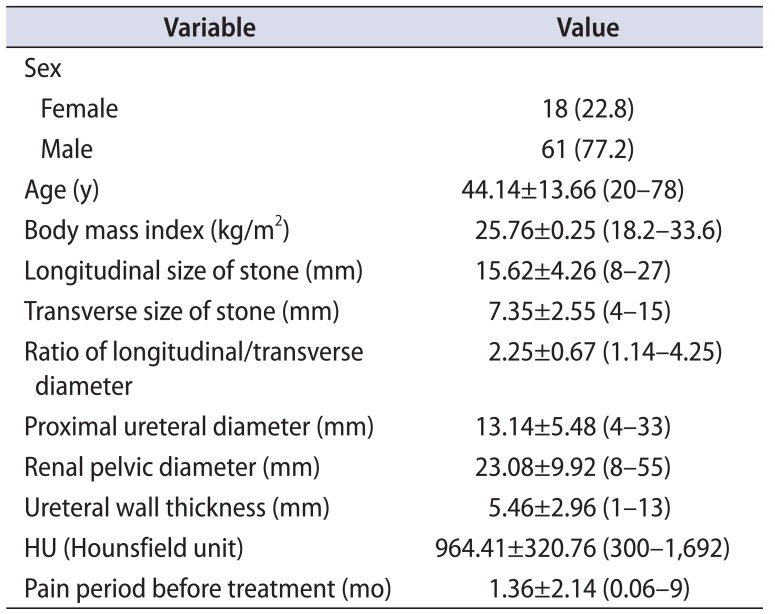
Table 2
Evaluation of the relationship between ureteral wall thickness and clinical as well as radiological findings
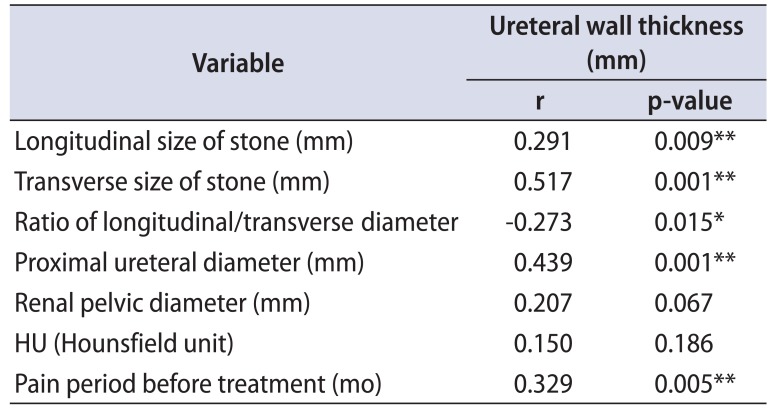




 PDF
PDF ePub
ePub Citation
Citation Print
Print


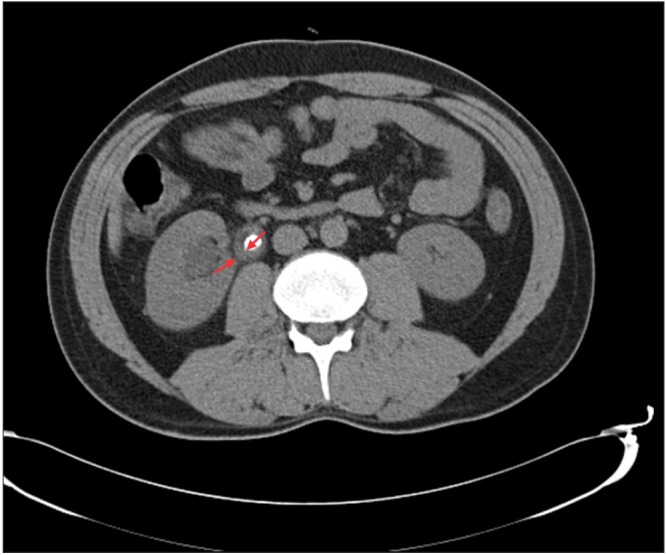
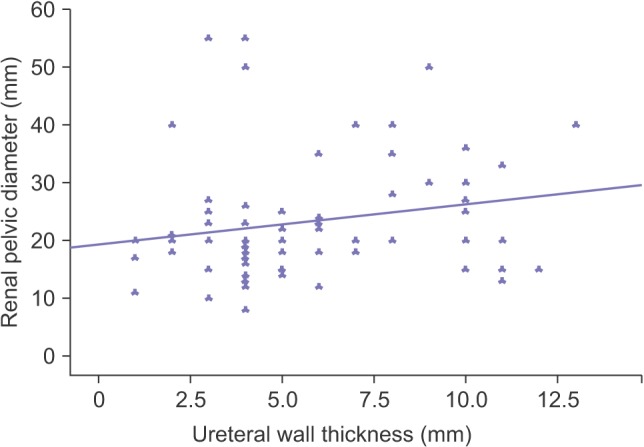

 XML Download
XML Download